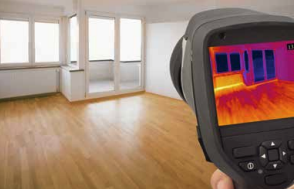Is Mold Hiding in Your Walls? Here’s How We…
WE HAVE A TRICK TO SPOT IT
 As I write this, we’re right in the middle of hurricane season, and that means it’s also the season for mold. No one wants to deal with the aftermath of a hurricane (and I hope you don’t have to), but they’re notorious for causing leaks and pesky mold, even in commercial buildings built to be hurricane-resistant. Fortunately, I have a fool-proof method for spotting leaks that’s straight out of NCIS: a thermal imaging camera.
As I write this, we’re right in the middle of hurricane season, and that means it’s also the season for mold. No one wants to deal with the aftermath of a hurricane (and I hope you don’t have to), but they’re notorious for causing leaks and pesky mold, even in commercial buildings built to be hurricane-resistant. Fortunately, I have a fool-proof method for spotting leaks that’s straight out of NCIS: a thermal imaging camera.
Now, I don’t mean I really have the kind of camera heroes use in action movies and cop shows. The idea of pointing a camera at a building from across the street and expecting to count the number of people inside is just a Hollywood trick. My thermal imaging camera can’t spot enemies like Hollywood magic, but it can identify temperature differences on surfaces. This is even more important, because those temperature differences are a clear indicator of water and, if you’re unlucky, mold.
Wet, moldy surfaces show up on the thermal imaging camera for one of two reasons. Either they’re cooler than the wall, floor, or ceiling around them because of the building’s air conditioning, or they’re warmer because the moisture is coming from outside. Either way, the camera will pick up the problem.
Confirming that you have a leak and/or a mold issue may require the use of a moisture meter in addition to a thermal imaging camera, but often I can rely on my years of experience looking at buildings during hurricane season. If you think you may have a leak on your hands, call me right away. I’ll come by with my camera, take a thorough scan of your building, and put your fears to rest.
That said, rainwater leaking in from outside isn’t the only cause of wet spots and mold in commercial buildings. Every year in late August and early September, I receive calls from building managers about mysterious blooms of mold in their stairwells. These blooms often occur in high-rise buildings, and at first, their presence confused me. Then, my thermal imaging camera revealed a pattern. Almost without fail, the mold grows on an area of stairwell wall that abuts a very cold room, like the space where computer servers are kept.
Here’s how it works: When computer rooms are built, the walls often are not sufficiently insulated. That means that the cold air of the computer room isn’t fully separated from the warm air of the stairwell. Consequently, the warm, humid air in the stairwell comes into contact with the cool wall surface. The air then chills down enough to reach dew point, forming droplets of water on the wall. This condensation is all it takes to form mold!
If you have a bloom of mold in your stairwell, I’d highly recommend scheduling a thermal imaging scan with me. I can figure out whether your building is suffering from this common problem (or one of the many other causes of dew point) and point you toward solutions like reinsulating the wall or adjusting the temperature of the stairwell or abutting room.
No tenant wants to work in a moldy building, so the more proactive you are about these pesky mold issues, the happier and more profitable you’ll be!

